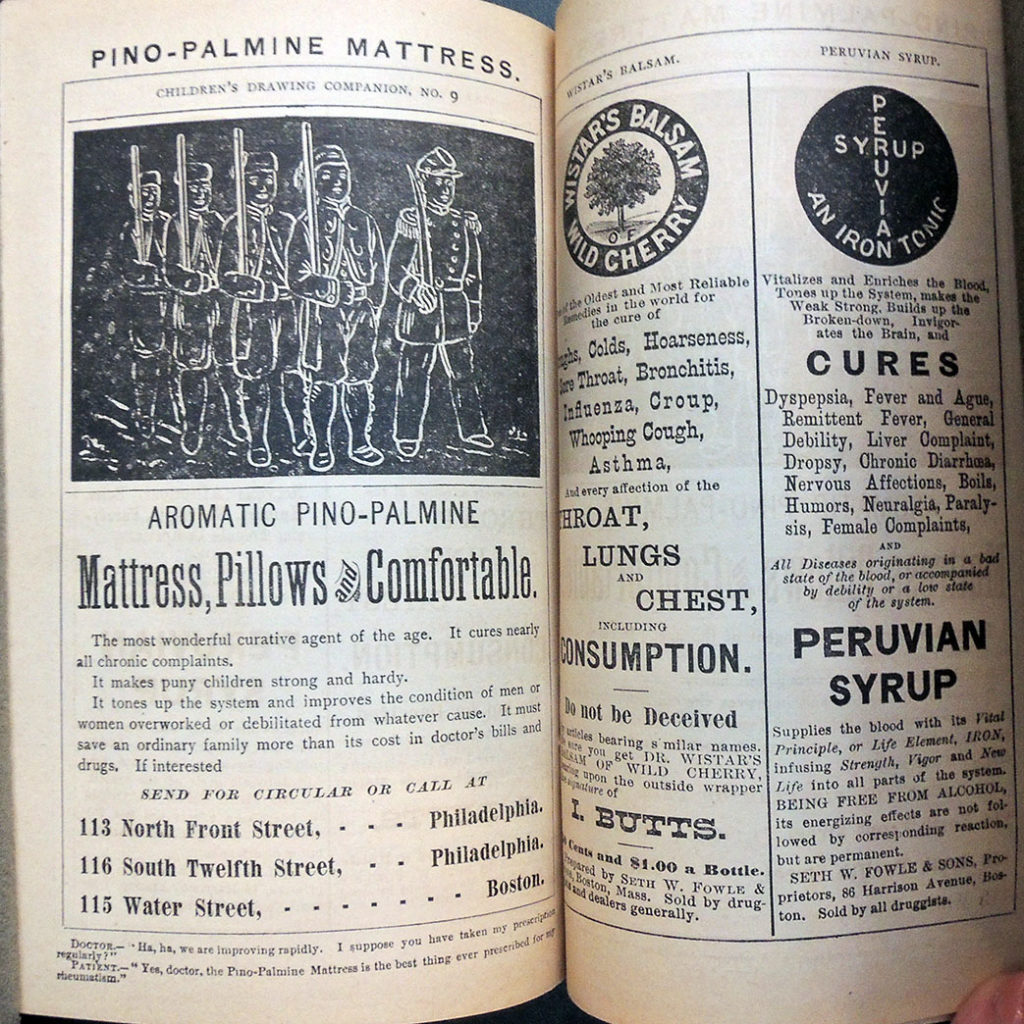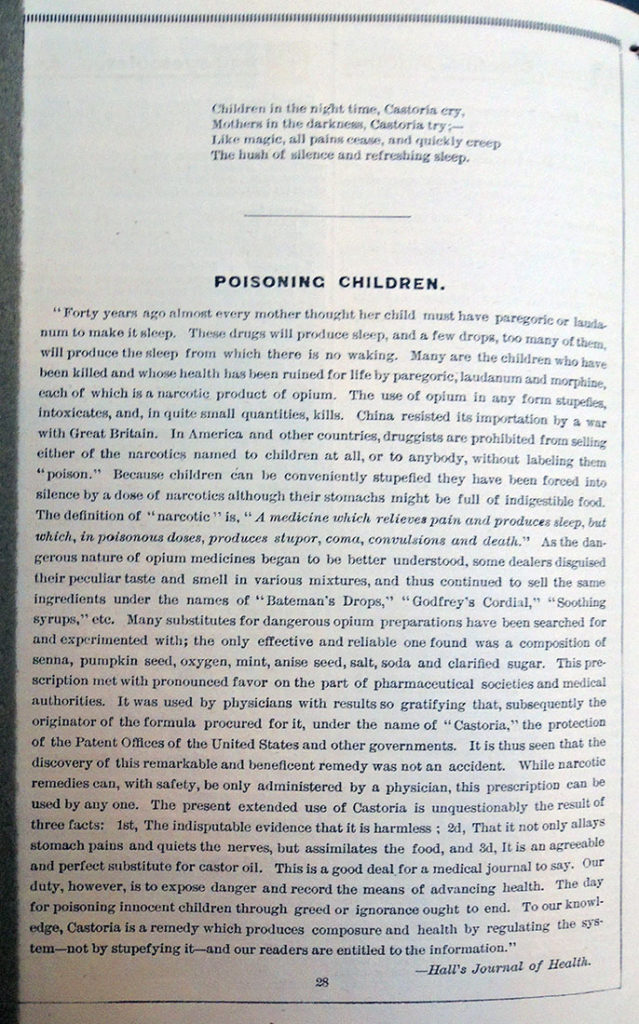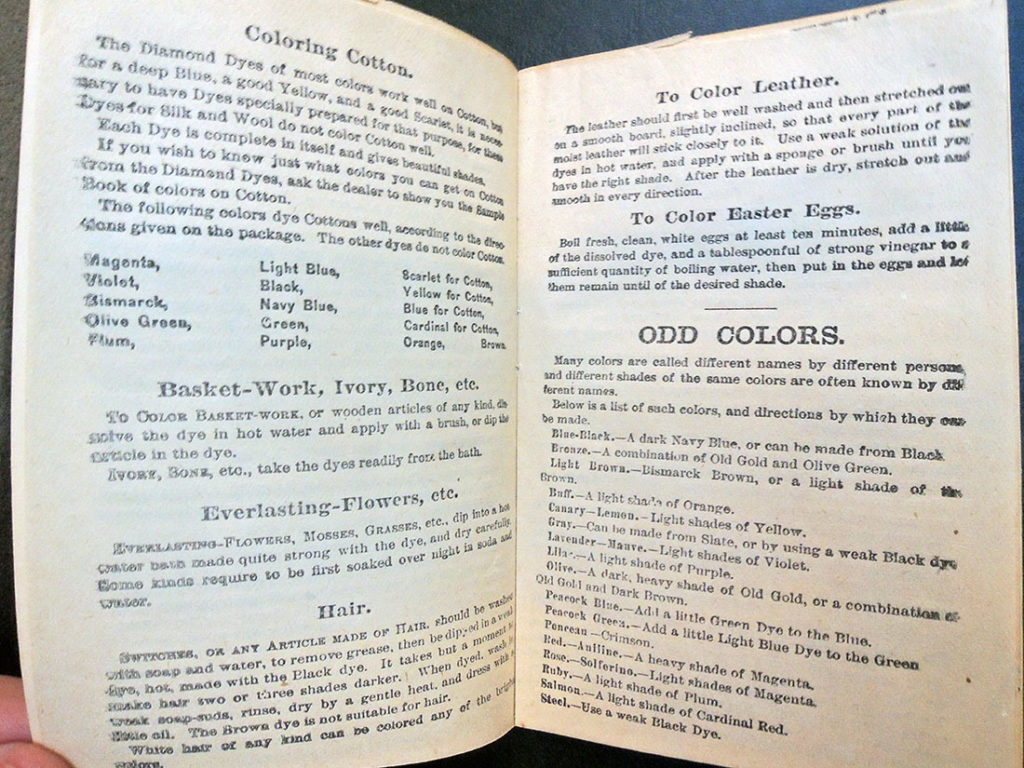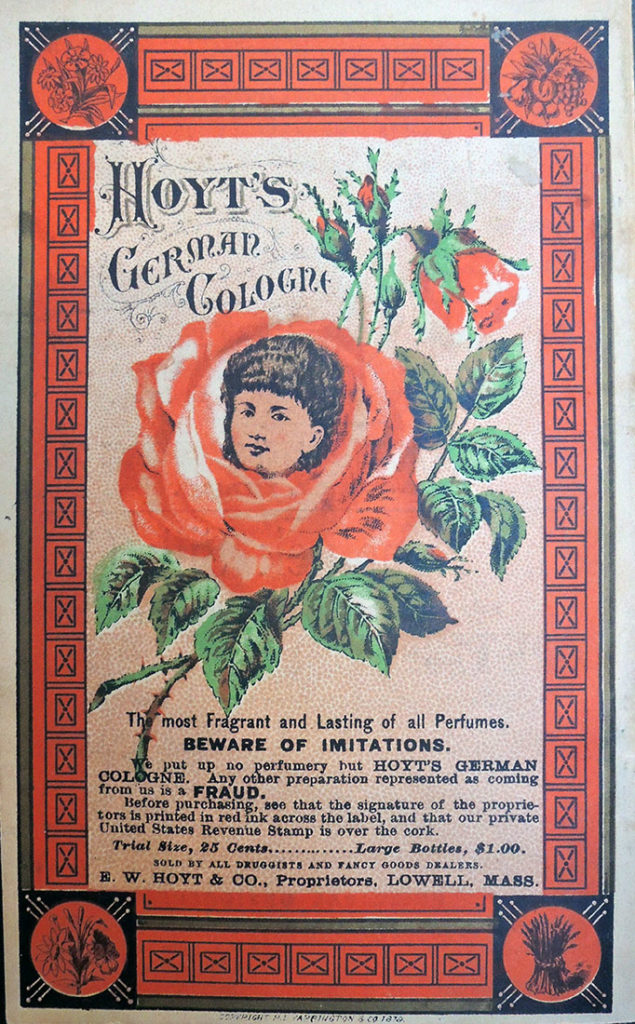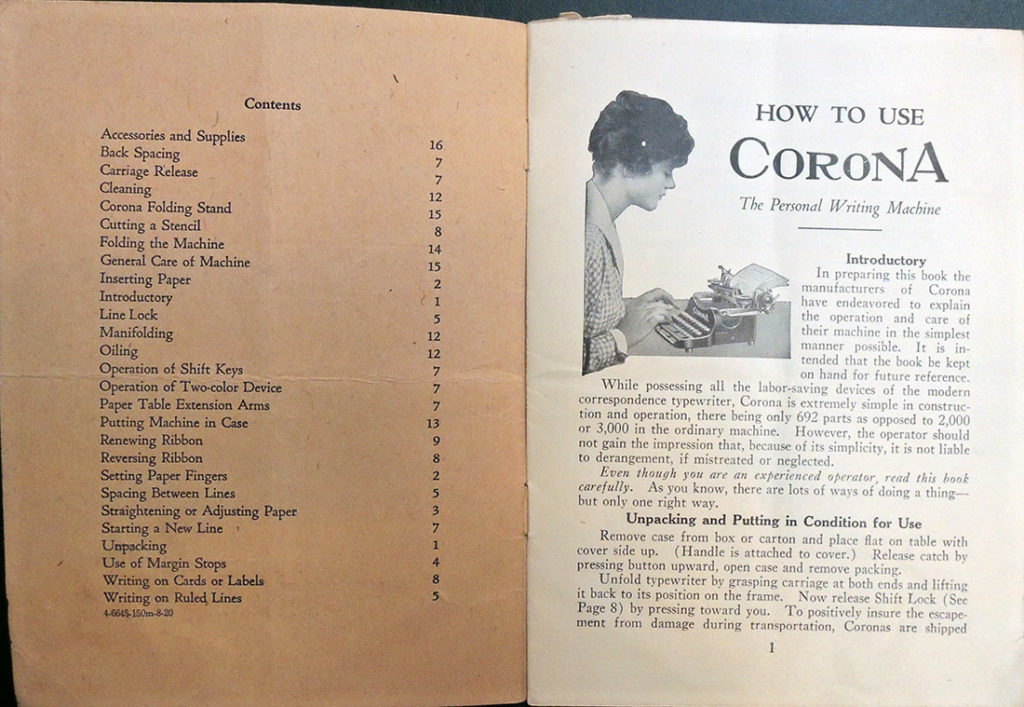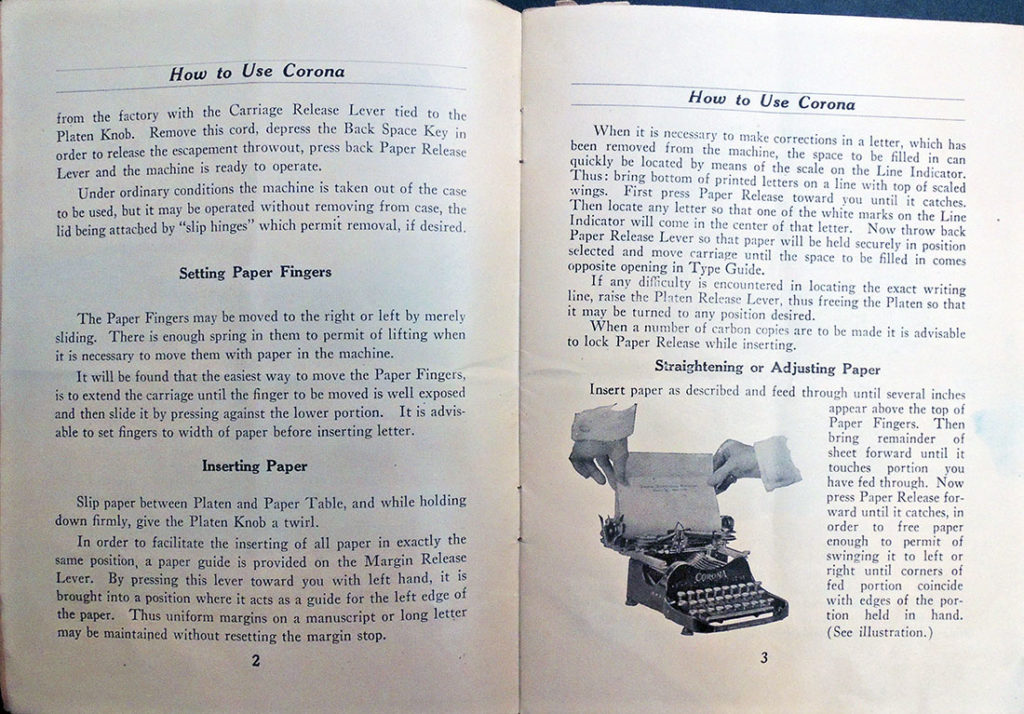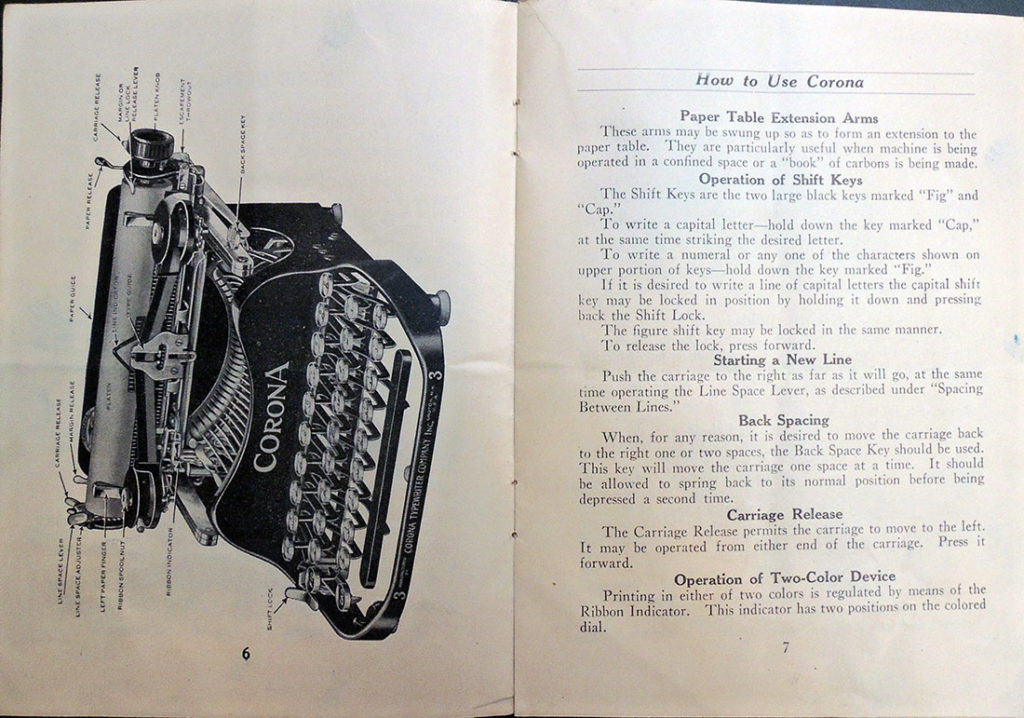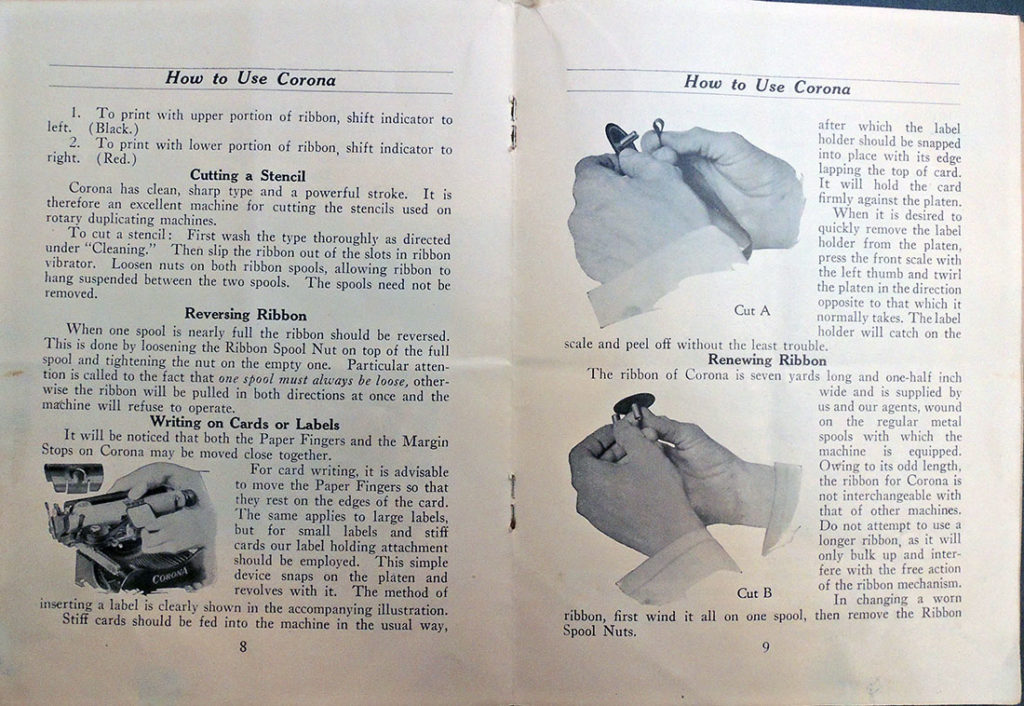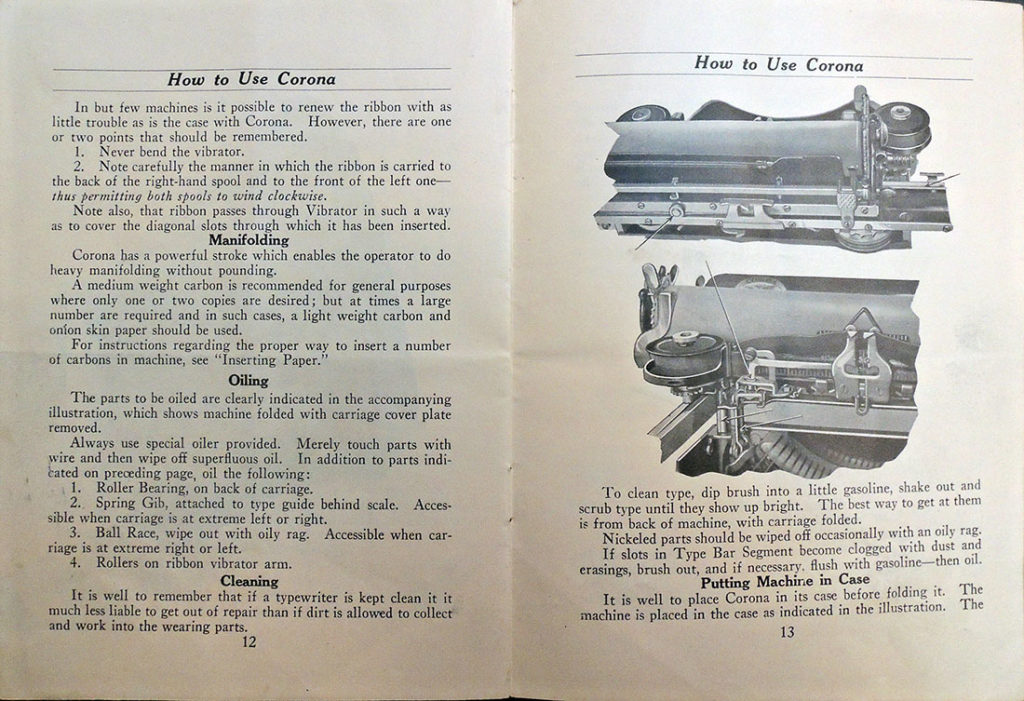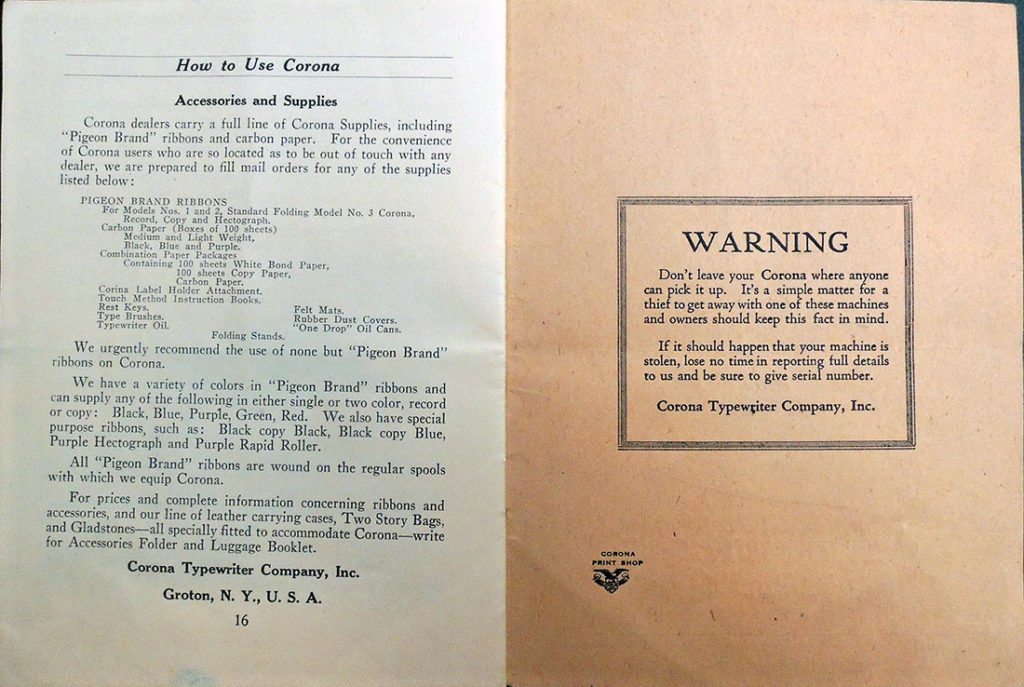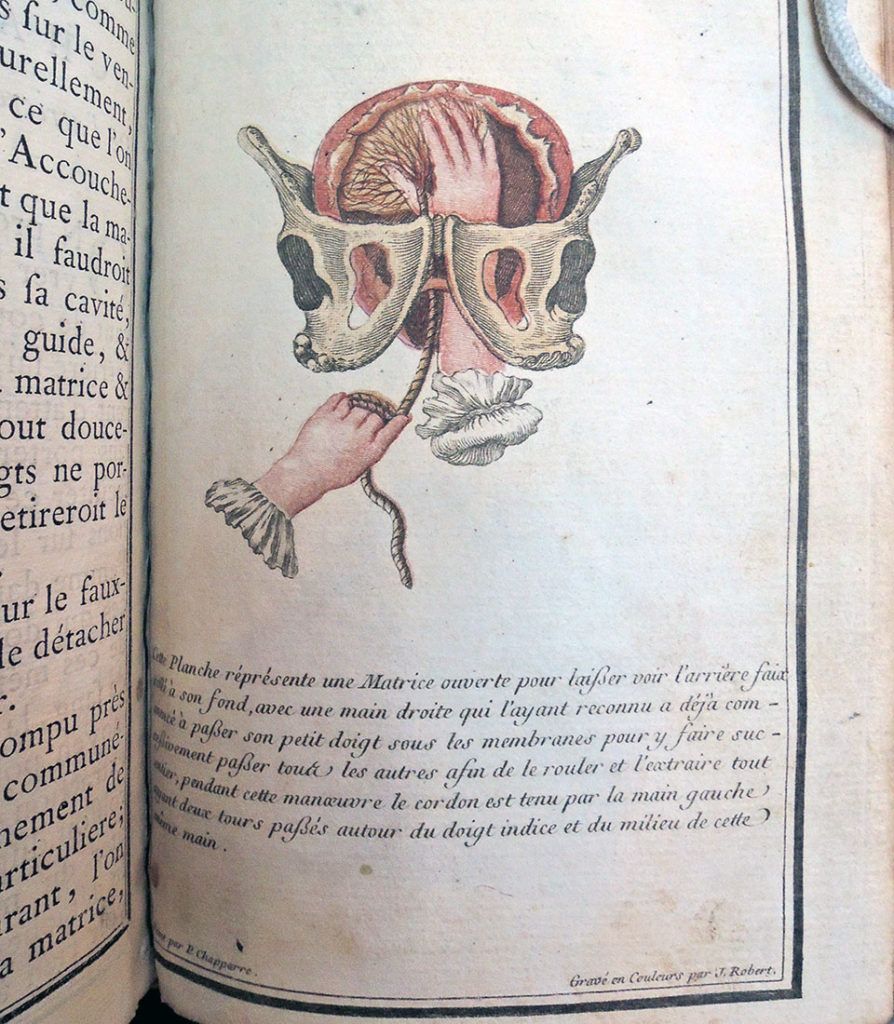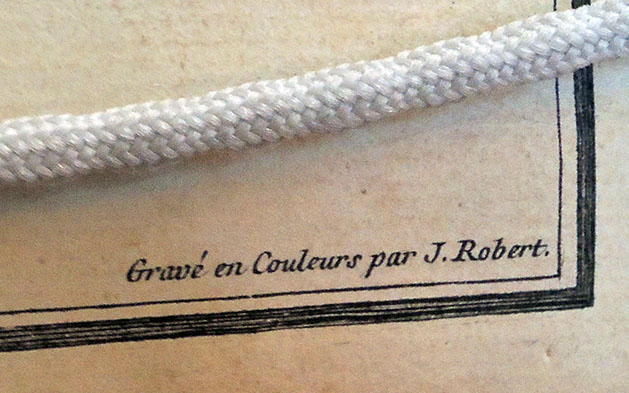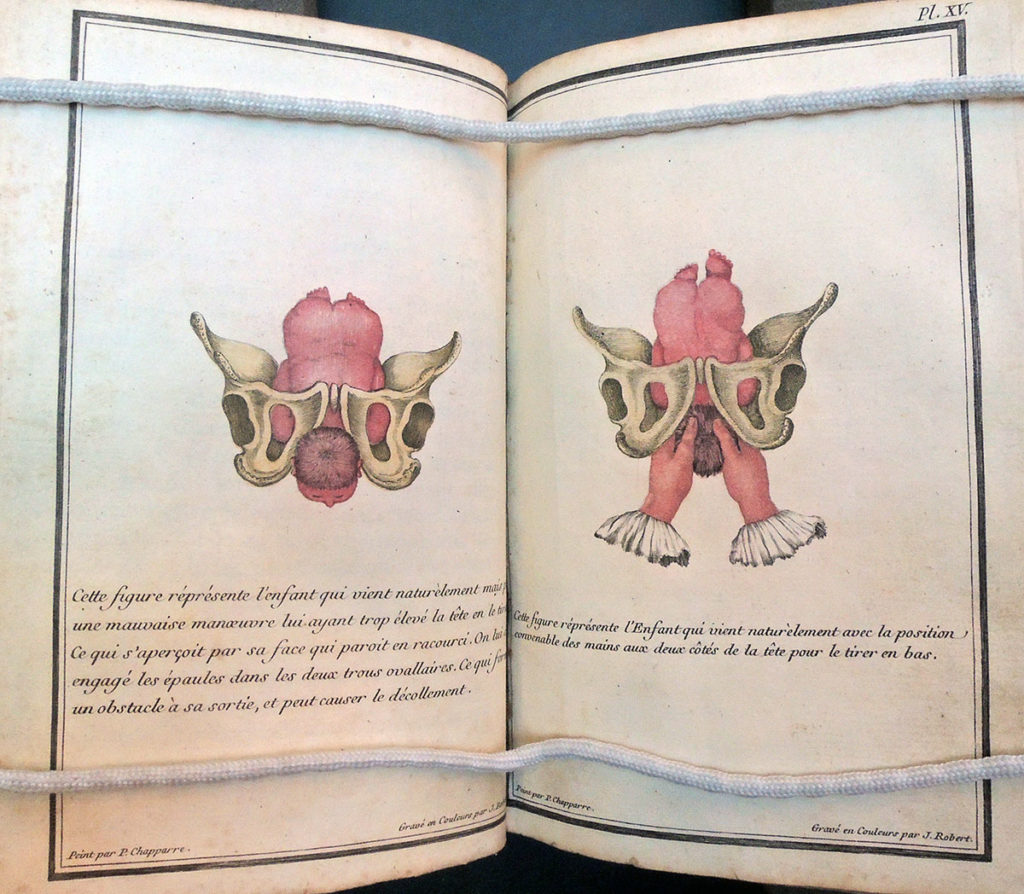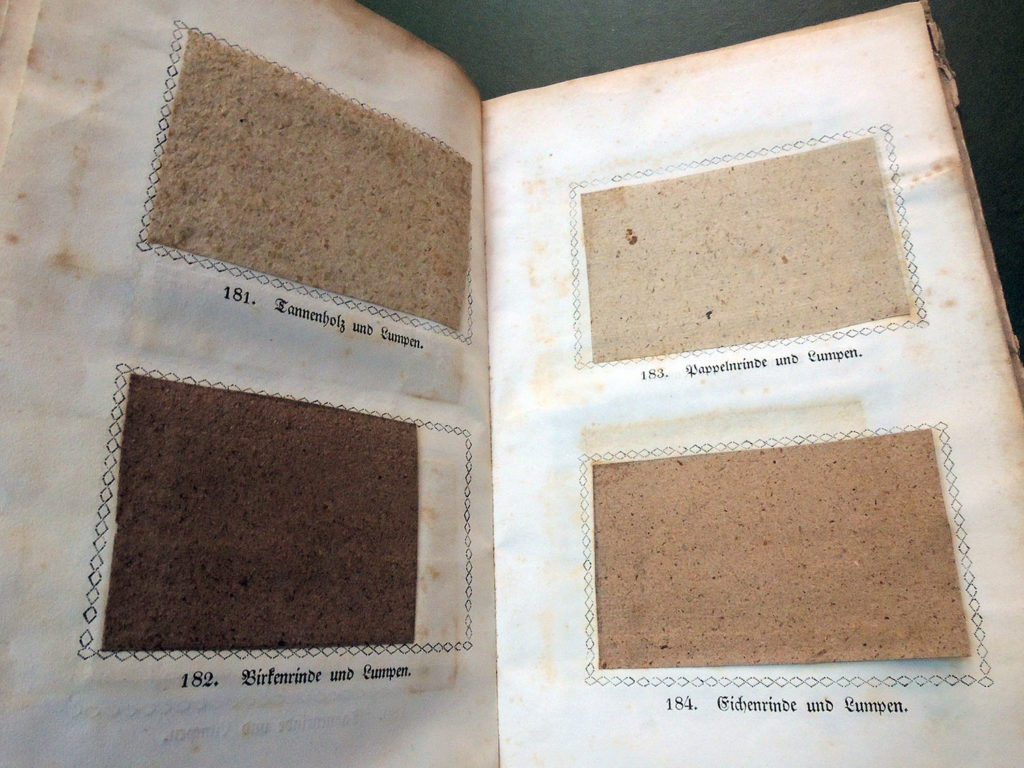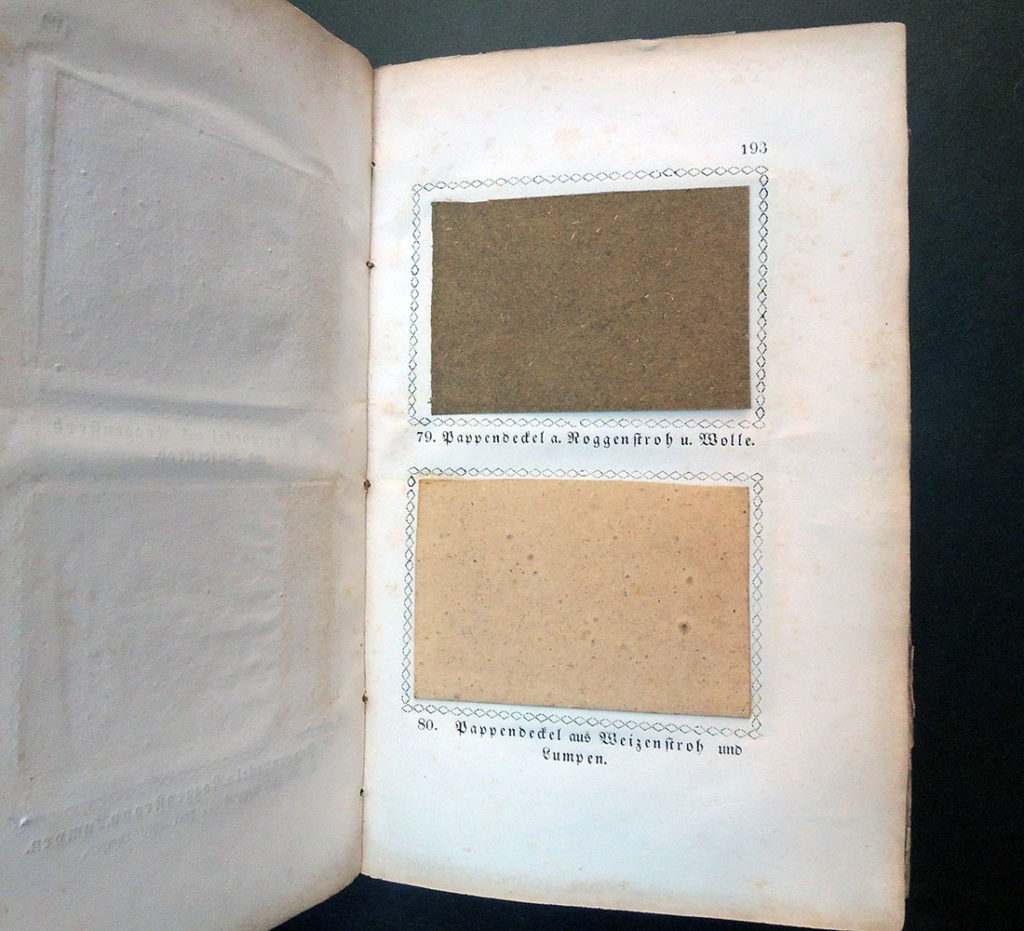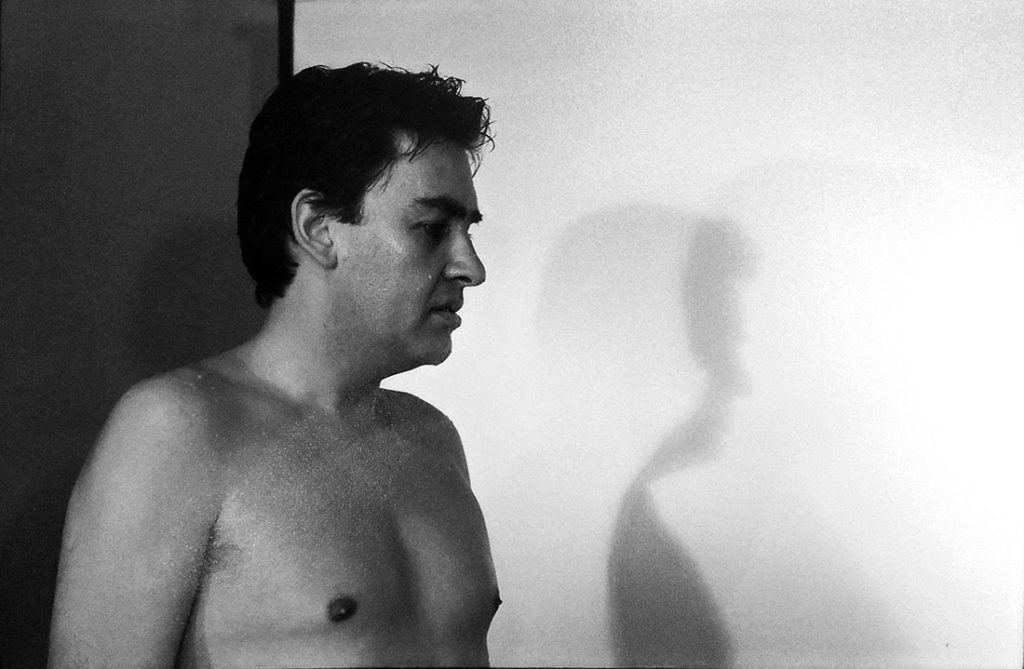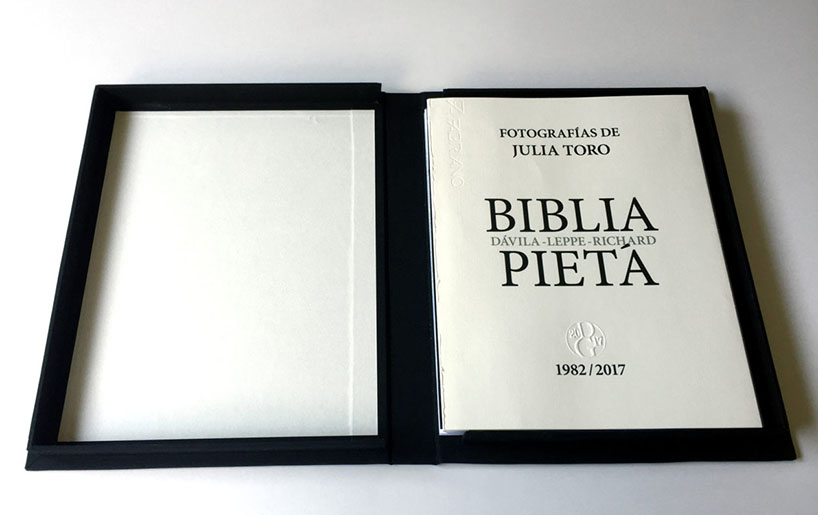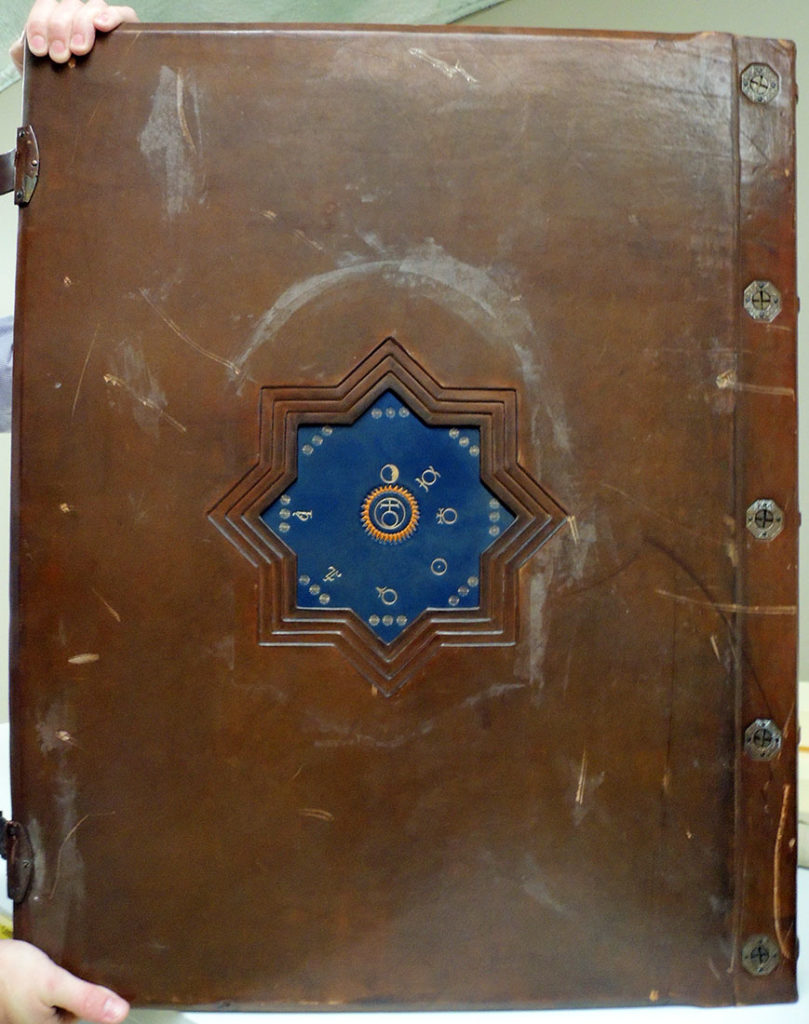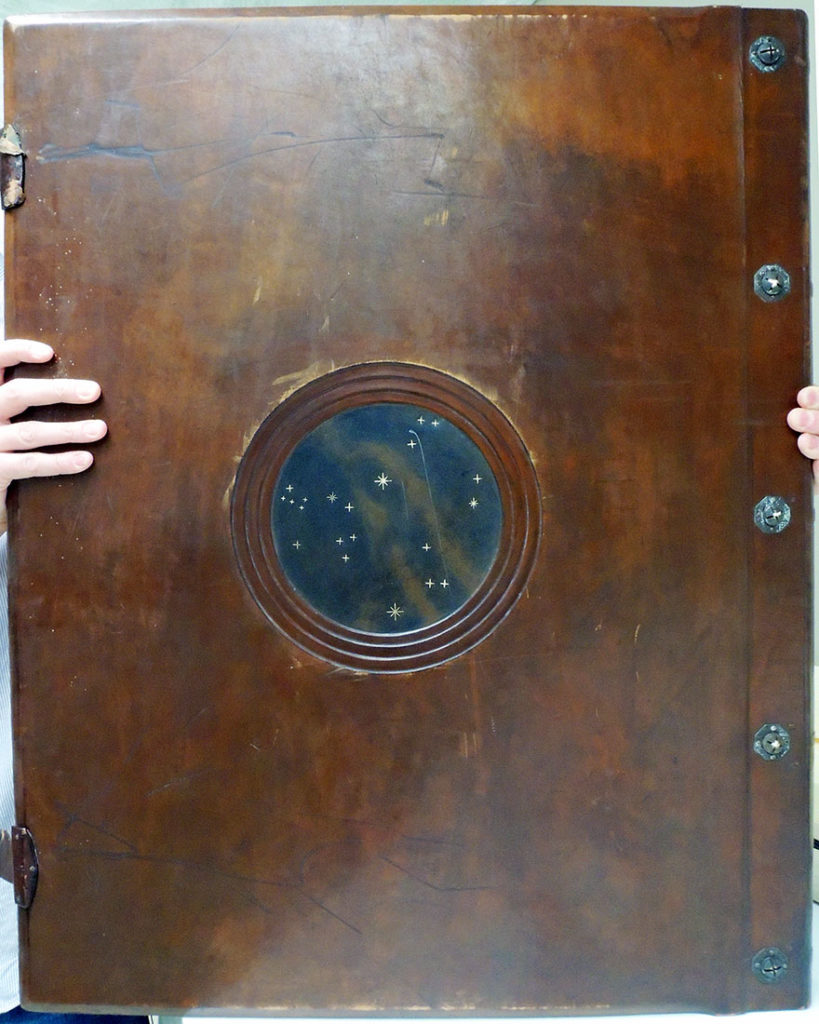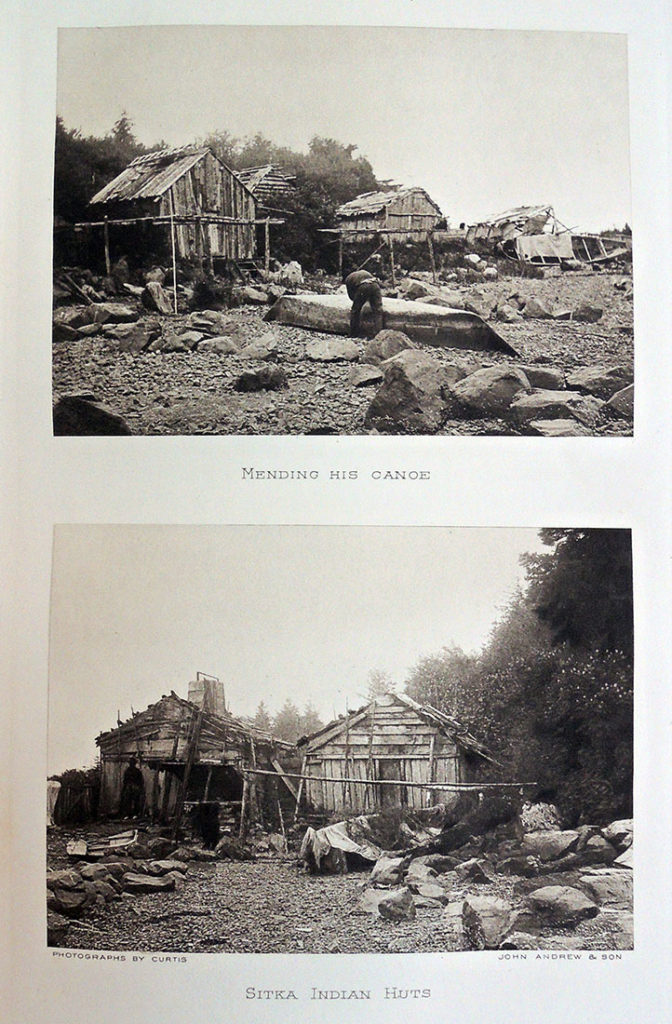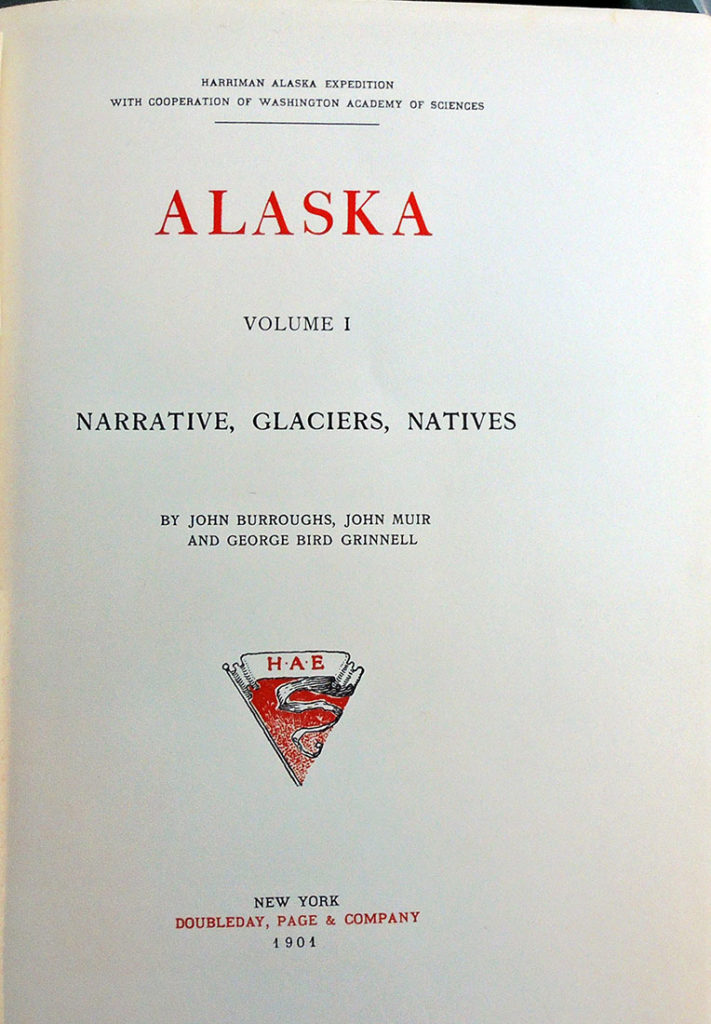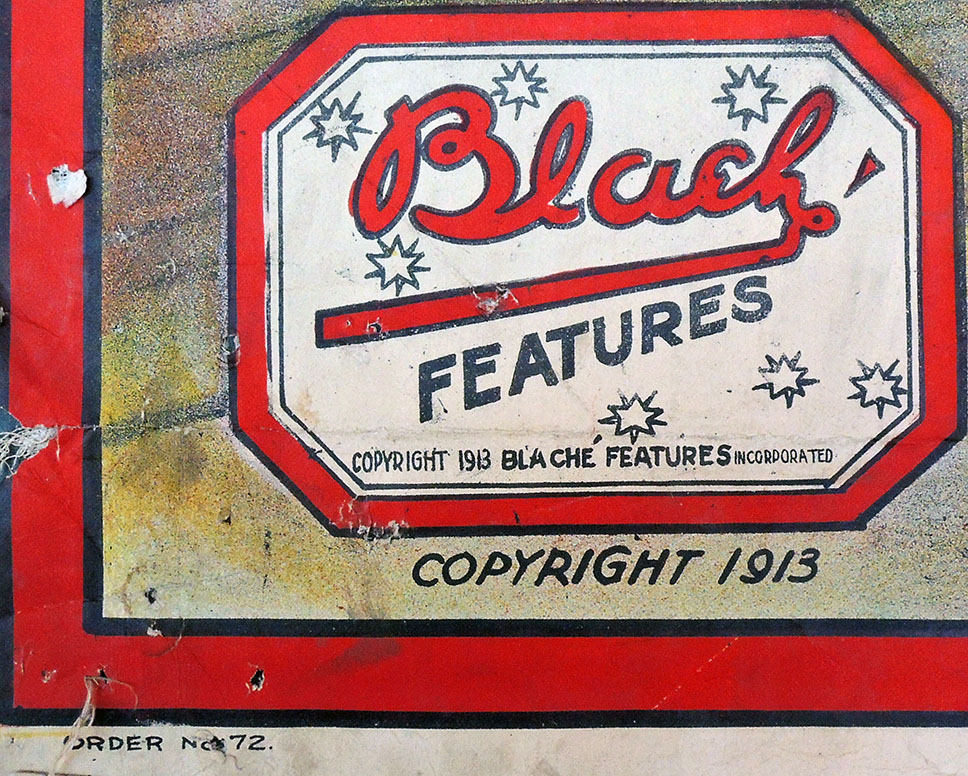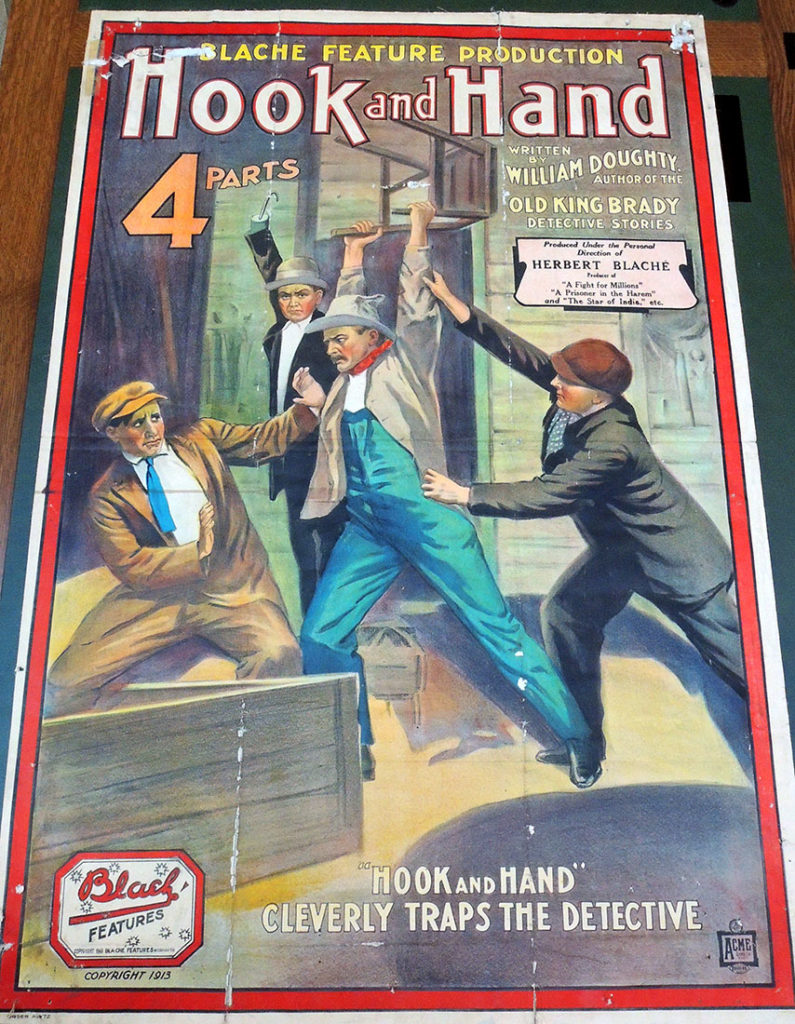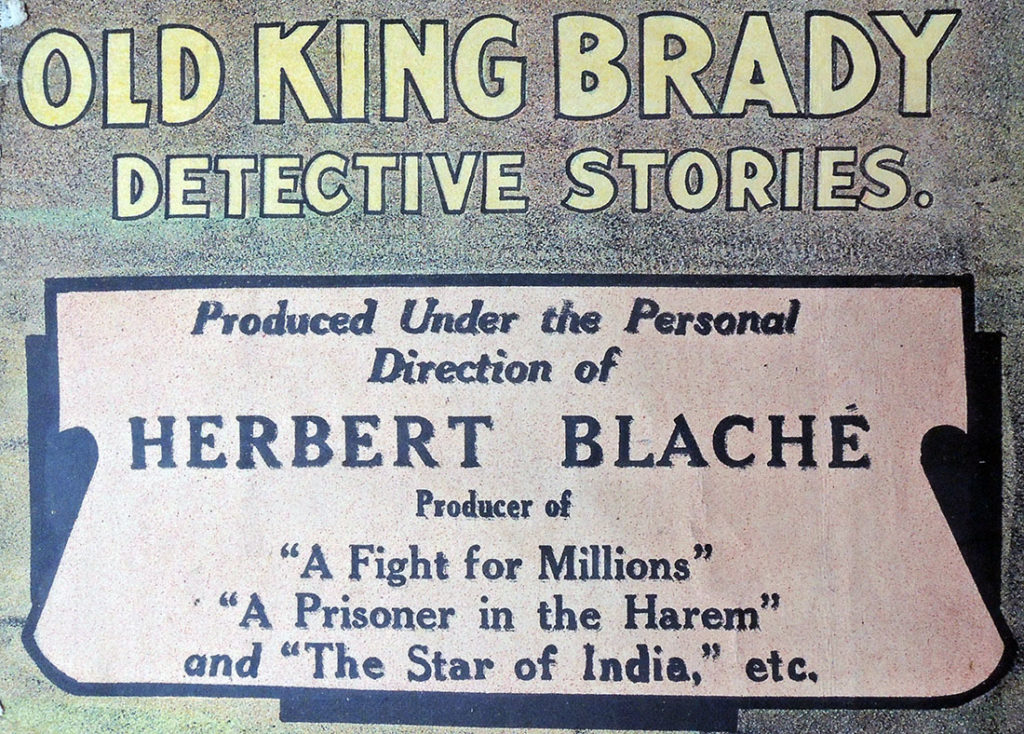 For 19th-century wives who did not have servants, advertisers published a wide variety of help books. Princeton University Library has a large and varied collection of household helpers, guides to home-making, manuals for entertaining, and other ephemeral publications. These few just passed by on the way to cataloguing with interesting remedies, receipts, shopping tips, advise on raising children, sewing diagrams, and many other articles along with advertisements. The Smithsonian did a nice online exhibition: http://www.sil.si.edu/ondisplay/making-homemaker/index.htm.
For 19th-century wives who did not have servants, advertisers published a wide variety of help books. Princeton University Library has a large and varied collection of household helpers, guides to home-making, manuals for entertaining, and other ephemeral publications. These few just passed by on the way to cataloguing with interesting remedies, receipts, shopping tips, advise on raising children, sewing diagrams, and many other articles along with advertisements. The Smithsonian did a nice online exhibition: http://www.sil.si.edu/ondisplay/making-homemaker/index.htm.
Author Archives: Julie Mellby
A Personal Writing Machine
The Longest Purse in Wall Street
Inside a box of unprocessed material, this small group of “Nickel Weeklies” (a cheaper version of the Dime Novels) turned up. Some of the major series titles are included here, Work and Win: An Interesting Weekly for Young America (featuring Fred Fearnot), Pluck and Luck, and Tip Top Weekly: An Ideal Publication for the American Youth (featuring Dick Merriwell). Each sold for 5 cents, with a full color cover. There were 732 stories about Fearnot over 14 years written by Harvey K. Shackleford, under the pseudonym Hal Standish, until his death in 1906, and then by George W. Goode using the same penname.
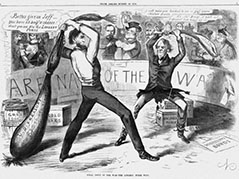 The January 13, 1905 issue of Work and Win features a story about Fred Fearnot with the subtitle “The Longest Purse in Wall Street” meaning the richest man. The saying “the longest purse wins” was featured prominently in a cartoon by William Newman published in the March 1, 1864 issue of Frank Leslie’s Budget of Fun, in which Jefferson Davis and Abraham Lincoln try to settle their disputes with enormous purses.
The January 13, 1905 issue of Work and Win features a story about Fred Fearnot with the subtitle “The Longest Purse in Wall Street” meaning the richest man. The saying “the longest purse wins” was featured prominently in a cartoon by William Newman published in the March 1, 1864 issue of Frank Leslie’s Budget of Fun, in which Jefferson Davis and Abraham Lincoln try to settle their disputes with enormous purses.
Here is a short biography for Newman from The Vault at Pfaffs
…In 1841, he was invited “to join a new, superior, three penny weekly to be called Punch.” Newman’s primary role at Punch was to provide small cuts, while on occasion he did some large cuts. By 1850, he had left Punch and had taken up work as a bookseller. He returned to journalism in 1854 as a cartoonist for Diogenes. In the winter of 1860, struggling to make ends meet for his growing family and wife, Newman was offered a job that offered more stability. The position was the “chief cartoonist for a new humor magazine, to be called Momus, which would cause him to relocate across the ocean in New York (Brown and West 158). While “all cartoons in Momus by Newman have previously been ascribed to William North,” a myth that was perpetuated by Frank Luther, scholars Jane Brown and Richard Samuel West have disproven such a notion. As they demonstrate, “North had committed suicide on November 14, 1854,” so it would have been impossible for North to have completed this work. With the demise of Momus in sight, “Newman found work on Frank Leslie’s Budget of Fun, the best of the American comic monthlies. …During the Civil War, Newman also “became part of the corps of artists bringing scenes of the war into the parlors of North homes” with contributions to both the New York Illustrated News and Harper’s Weekly. In the fall of 1862, he began to contribute work again to one of Leslie’s publications, Frank Leslie’s Budget of Fun, which continued relatively consistently for the next eight years. According to biographers Brown and West, “after the War, Newman paid less attention to national politics and more to American foreign policy and international affairs,” especially the relations between the United States and England and France.
The Cotsen Collection holds Work and Win no.1-1382; 1896-1924. ReCAP – Cotsen Library Off-Site Storage Work and win 151026
The Gutenberg Bible in popular culture
We were chatting yesterday about moments in popular culture when a Gutenberg Bible turns up. Here is one such episode on the sit-com Newhart.
Newhart, May 12, 1986 entitled “Pre-Nups,” in which the “Loudons, George, Steph, and Michael are invited to Vanderkellen mansion for Arthur’s birthday. Dick worries when he breaks a music box given to Arthur by Winston Churchill.”
There are many attempts to steal a Gutenberg Bible in books and movies, including The Art of the Steal. Note the black and white illuminations.
Below is an episode of Provenance from February 4, 2014, in which “Reese rejoins Finch in New York, but when the team receives the number of a highly skilled antiquities thief, a surprising turn of events finds them planning a heist which could land them all in jail.”
Here is a link to a fairly long clip from Francis Ford Coppola’s 1966 film You’re A Big Boy Now. “Bernard Chanticleer, called “Big Boy” by his parents, is 19 but still lives with his overbearing, clinging mother and his commanding, disapproving father, who is Curator of Incunabula at the New York Public Library.” *It might begin with a commercial.
http://fw.to/AeR8X5e
Can you think of others? jmellby@princeton.edu
Color printing by Jean Robert, assistant to J. C. Le Blon
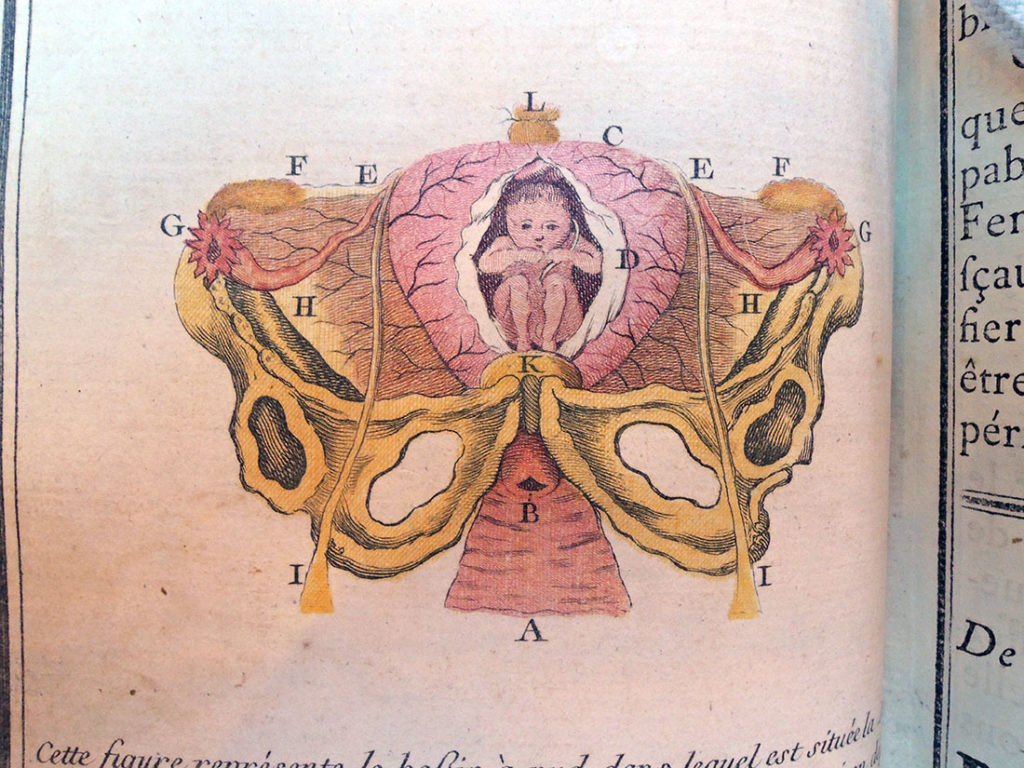
For those who study the history of printed color, the German printer Jacob Christoph Le Blon (1667-1741) is celebrated for his development of three and four color prints. We usually think of the deluxe editions he produced but forget his three-color system was also used on simple, utilitarian volumes.
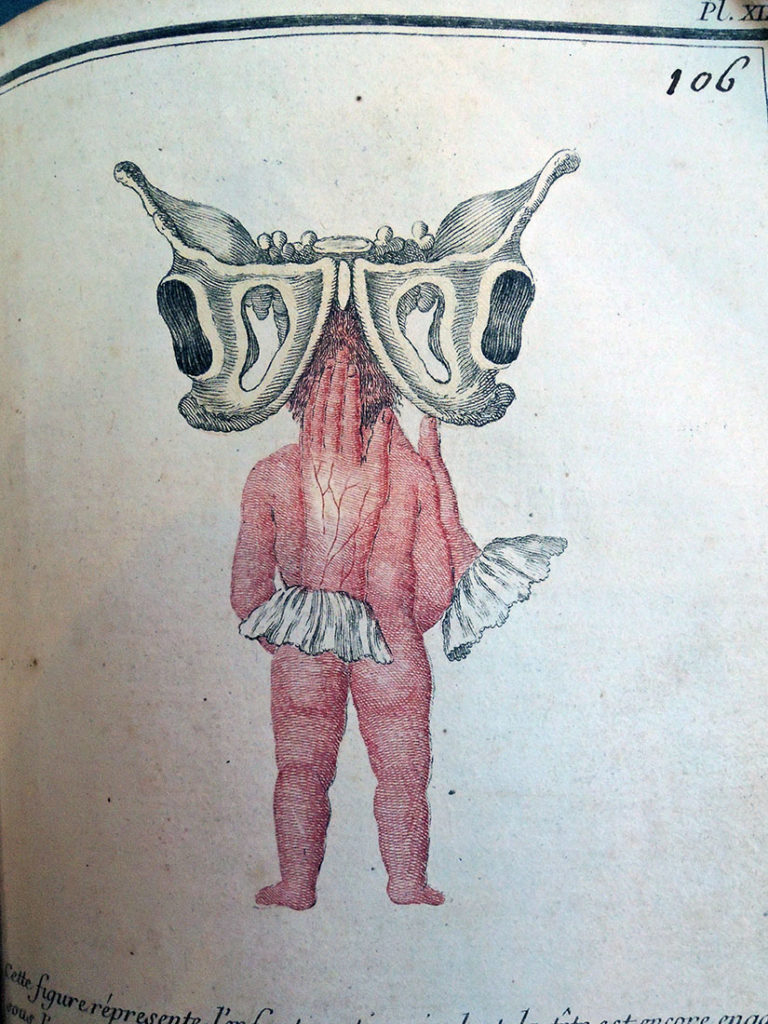 Thanks go to Charles B. Wood III, who found this work on obstetrics by Angélique Marguerite Le Boursier Du Coudray (1712-1789). the pioneering midwife who published the manual on childbirth, developed from the lectures and classes she gave throughout Europe. The illustrations are beautifully printed in colors by Le Blon’s assistant Jean Robert (active 1746-1782) and the frontispiece portrait of Du Coudray is also engraved by Robert.
Thanks go to Charles B. Wood III, who found this work on obstetrics by Angélique Marguerite Le Boursier Du Coudray (1712-1789). the pioneering midwife who published the manual on childbirth, developed from the lectures and classes she gave throughout Europe. The illustrations are beautifully printed in colors by Le Blon’s assistant Jean Robert (active 1746-1782) and the frontispiece portrait of Du Coudray is also engraved by Robert.
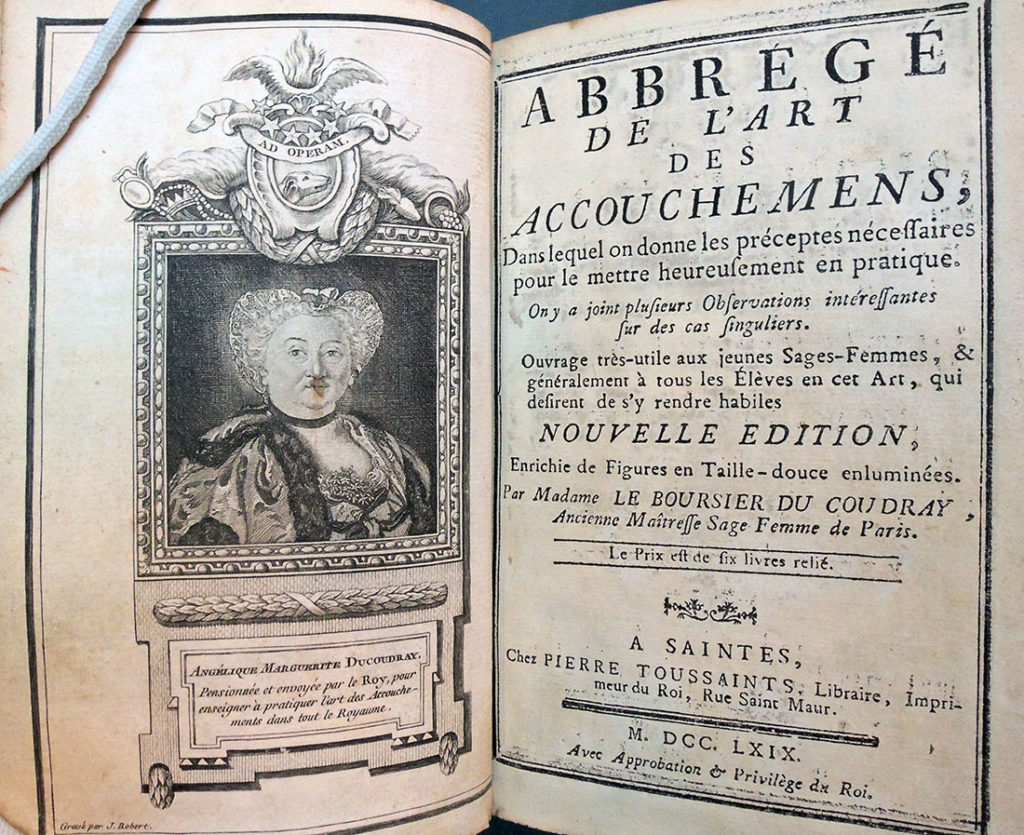 Angélique Marguerite Le Boursier du Coudray (1715-1794), Abbrégé de l’art des accouchemens, dans lequel on donne les préceptes nécessaires pour le mettre heureusement en pratique. On y a joint plusieurs observations intéressantes sur des cas singuliers. Ouvrage très-utile aux jeunes Sages-Femmes, & généralement à tous les éléves en cet art, qui désirent de s’y rendre habiles. Nouvelle édition, enrichie de figures en taille-douce enluminées. Par Madame Le Boursier du Coudray, ancienne maîtresse sage-femme de Paris (Saintes: Pierre Toussaints. Libraire, imprimeur du Roi, rue Saint Maur. M. DCC. LXIX [1769]). Rare Books and Special Collections RG93 .xD8
Angélique Marguerite Le Boursier du Coudray (1715-1794), Abbrégé de l’art des accouchemens, dans lequel on donne les préceptes nécessaires pour le mettre heureusement en pratique. On y a joint plusieurs observations intéressantes sur des cas singuliers. Ouvrage très-utile aux jeunes Sages-Femmes, & généralement à tous les éléves en cet art, qui désirent de s’y rendre habiles. Nouvelle édition, enrichie de figures en taille-douce enluminées. Par Madame Le Boursier du Coudray, ancienne maîtresse sage-femme de Paris (Saintes: Pierre Toussaints. Libraire, imprimeur du Roi, rue Saint Maur. M. DCC. LXIX [1769]). Rare Books and Special Collections RG93 .xD8
See also the 1756 book engraved by Pierre François Tardieu (1711–1771) and Jean Robert (active 1746–1782), and printed by Pierre Gilles Le Mercier (active 1735–1766): “Coloritto or the Harmony of Colouring in Painting” in Antoine Gautier de Montdorge (1701-1768), L’art d’imprimer les tableaux, traité d’après les écrits, les opérations & les instructions verbales, de J. C. Le Blon (Paris: Chés P. G. Le Mercier … Jean-Luc Nyon … Michel Lambert … 1756). Graphic Arts Collection 2004-3391N.
Paper made from straw (rye, wheat, barley, oats, peas, beans, lentils, and corn)
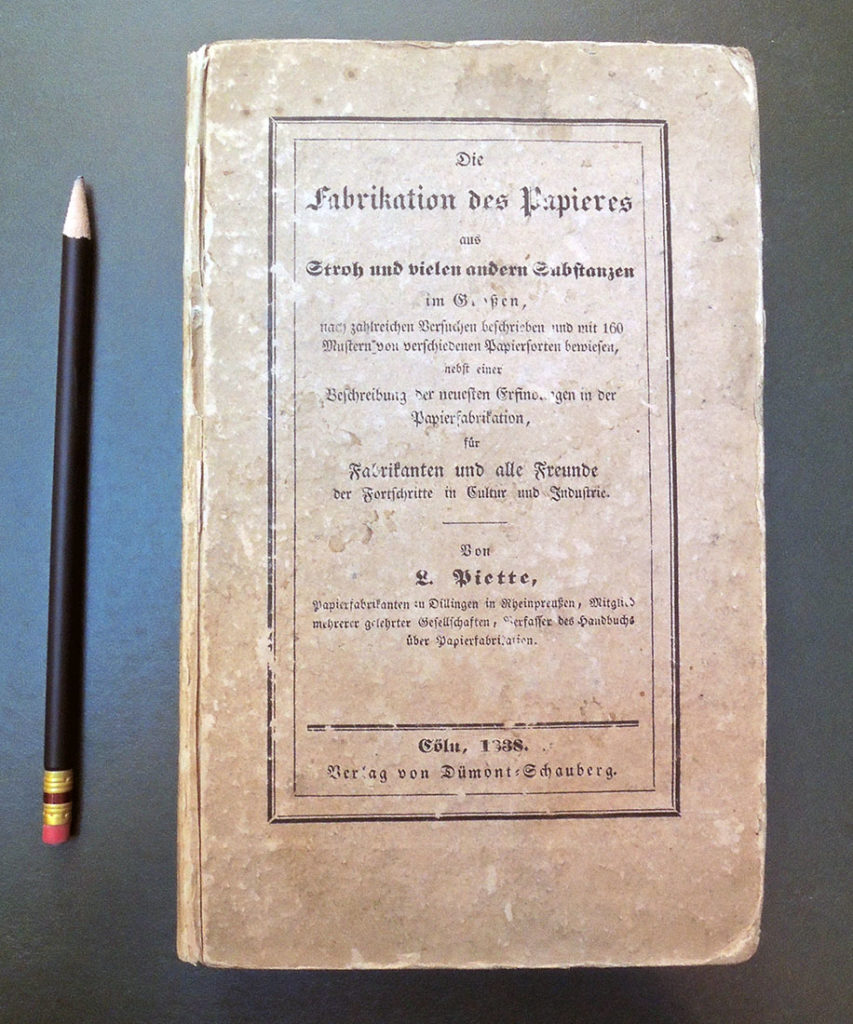
Louis Piette (1803-1862), Die Fabrikation des Papieres aus Stroh und vielen andern Substanzen: im Grossen nach zahlreichen Versuchen beschrieben und mit 160 Mustern von verschiedenen Papiersorten beweisen: nebst einer Beschreibung der neuesten Erfindungen in der Papierfabrikation, für Fabrikanten und alle Freunde der Forschritte in Cultur und Industrie (Cologne: Dümont-Schauberg, 1838). Graphic Arts Collection GAX 2018- in process
The Graphic Arts Collection has a number of early sources on papermaking, often with paper samples tipped in. This volume, recently acquired, is not the earliest but certainly is one of the rarest of all papermaking books, with 25 more samples than most other recorded copies (ok, yes, the copy at the University of Amsterdam apparently has 192 samples but who’s counting).
The papers are chiefly from various kinds of straw (rye, wheat, barley, oats, peas, beans, lentils, and corn), singly or in combination; some mixed with hay and/or rags; and some bleached or colored. There are also five samples of cardboard made from straw and other fibers and ten non-straw papers (hay, oakum, wood, linden bark; some with rags).
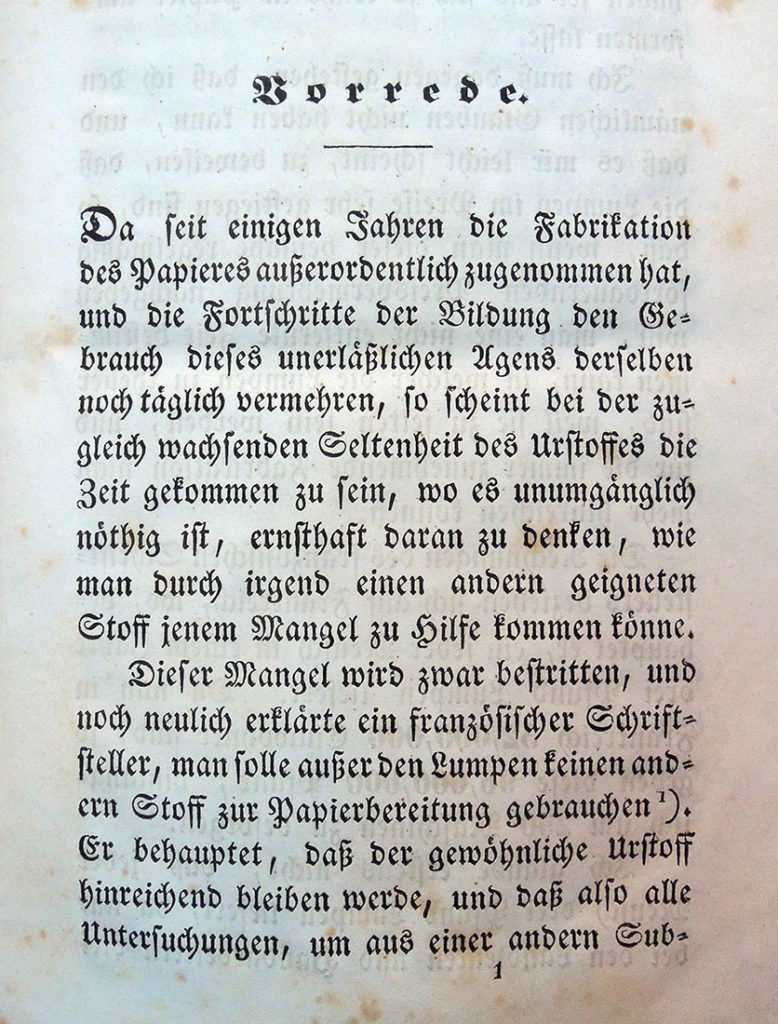
In 1827, Louis Piette, a native of Belgium, took over the paper making factory started by his father in Dillingen and performed many experiments using different materials to produce various suitable kinds of paper, operating the mill from 1819 to 1854. Note in particular leaves 203-33 are themselves made of various straw papers.
“Louis Piette followed in the footsteps of noted papermaking researchers of the 18th century…These early attempts, however, were not as successful as the finished papers made by Louis Piette. The significance of Piette’s investigations is very simple: his papers made from straw remain clean and almost as pliable as comparable papers made from rag…Piette’s papers, moreover, really are straw papers, without mixing in small amounts of flax fibers. Piette’s experiments showed a great understanding of papermaking from a production standpoint, and, with the increase use of the fourdrinier machine, his work led directly into the use of esparto grass prior to the discovery of chemical bleaching for soft- and hardwood paper manufacture…By the 1860‘s, the age of modern machine papermaking was at hand, and Piette’s earlier papermaking experiment showed how well he understood the future of papermaking.“–The Paper Trail. Quarterly Newsletter of the Robert C. Williams American Museum of Papermaking (Vol. 2, Nos. 1 & 2, January- March & April-June 2004). In these two articles the author states there are only four known copies of this book.
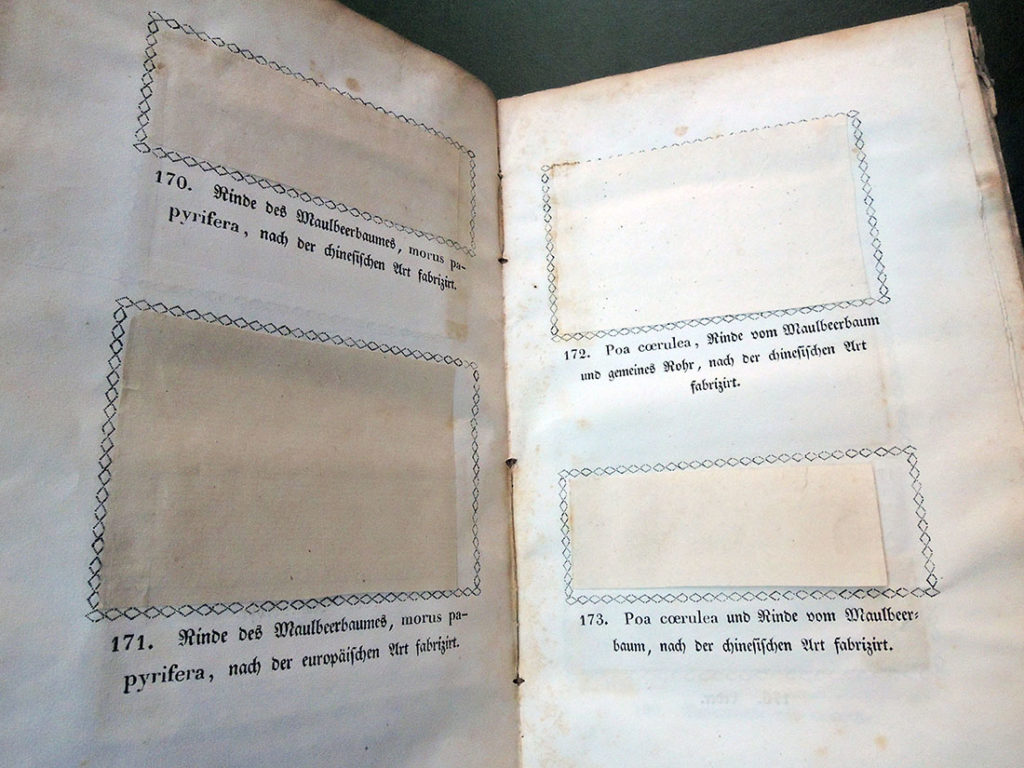
Of particular importance in this volume, found on pages 246-91 is the second printing of Moritz Illig’s Anleitung auf eine sichere, einfache und wohlfeile Art Papier in der Masses zu leimen (first edition 1806). According to Leonard Schlosser’s 1971exhibition catalogue, only two copies are known of the first edition. This text describes Illig’s “momentous” (Schlosser) invention of rosin-alum sizing. The addition of this mixture aided in making the paper take writing ink with less necessity for sizing with glue, as had been the vogue for five hundred years. It provided a simple, sure method for sizing paper more rapidly with non-putrescible materials. Illig’s book was literally consumed in use and only two copies are known.–Special thanks to Yoshi Hill for his research on this volume.
Some of the other early papermaking sources in the Graphic Arts Collection include:
Papeterie: contenant quatorze planches, dont une double ([A Paris: Chez Briasson … David … Le Breton …, 1767]. Graphic Arts Collection Oversize 2011-0013F
Louis-Charles Desnos (1725-1805), Dissertation historique sur l’invention des lettres, ou caracteres d’écriture: sur les instrumens dont les anciens se sont servi pour écrire; & sur les matières qu’ils ont employées: suivie d’une Instruction raisonnée sur le papier nouveau que le sieur Desnos annonce au public: & dont on trouvera à la fin une suite de feuillets pour écrire & dessiner dans tel genre que ce soit avec un stylet ou pointe d’un métal composé pour cet usage (Paris: Chez Desnos, ingénieur-géographe & libraire de Sa Majesté danoise … , 1771). The 52 blank leaves at end are samples of Denos’ paper, intended for use as a notebook; cf. p. 3 (2nd group). Graphic Arts Collection 2009-0605N
Charles-Michel, marquis de, Villette (1736-1793), Œuvres du marquis de Villette (Londres. [i.e. Langlée, France: P. A. Léorier Delisle], M. DCC. LXXXVI. [1786]). “Ce volume est imprimé sur le papier d’écorce de tilleul.”–Verso of half title. Based on the 18mo format, the sheet size is ca. 48 x 36 cm. (crown), though Hunter reported his copy as 16 x 10 cm. (thus ca. 60 x 48 cm, royal, calculated from the same format). Issued also on rose-colored paper and on paper made from marshmallow. Includes 20 sample leaves of Léorier Delisle’s experimental paper made from various plant materials: marshmallow, nettles, hops, moss, reeds, conferva (3 kinds), burdock, burdock-colt’s foot, and thistles; quack-grass root; hazel wood and spindle wood; and bark of willow, spindle tree, oak, poplar, osier and elm. Each leaf includes printed identification of the material used: papier de guimauve, d’ortie, de houblon, de mousse, de roseaux, de conferva (première / seconde / troisième espèce), de racines de chiendent, de bois de coudrier, de bois de fusain, d’écorce de fusain avec son épiderme ou croûte, d’écorce de chéne, d’écorce de peuplier, d’écorce d’osier, d’écorce d’orme, d’écorce de saule, de bardanne, de bardanne et de pas-d’ane, de chardons. Graphic Arts Collection 2004-0061S
Matthias Koops, Historical account of the substances which have been used to describe events, and to convey ideas, from the earliest date to the invention of paper (London: Printed by T. Burton …, 1800). “Printed on the first useful paper manufactured soley [sic] from straw.” Appendix (p. [85]-91) printed on “paper made from wood alone … without any intermixture of rags, waste paper, bark, straw, or any other vegetable substance.” Laid in: sample blank folded sheet of straw paper, 35 x 43 cm. folded to 18 x 12 cm. Watermark: “Neckinger Mill.” Graphic Arts Collection Oversize TS1090 .K66q
The Sister arts, or, A concise and interesting view of the nature and history of paper-making, printing, and bookbinding: being designed to unite entertainment with information concerning those arts, with which the cause of literature is peculiarly connected: embellished with three engravings ([Lewes]: Sussex Press, Lewes: Printed and published by J. Baxter, and sold by the principal booksellers in London, 1809). GAX copy: From the library of P. J. Conkwright. Graphic Arts Collection 2003-0052N
Biblia / Pietá
Biblia/Pietá originated from a performance art piece that took place in the Instituto Francés de Cultura (French Institute of Culture) in Santiago, Chile, during May 1982, created by Juan Domingo Dávila, Carlos Leppe, and the critic Nelly Richard. The event was recorded in photographs by Julia Toro Donoso and republished last year in a limited edition box set, recently acquired thanks to funds provided by the Program in Latin American Studies (PLAS). Special thanks go to Professor Javier Guerrero, Department of Spanish and Portuguese and Chair of the Section on Venezuelan Studies of LASA, who discovered this rare surviving box.
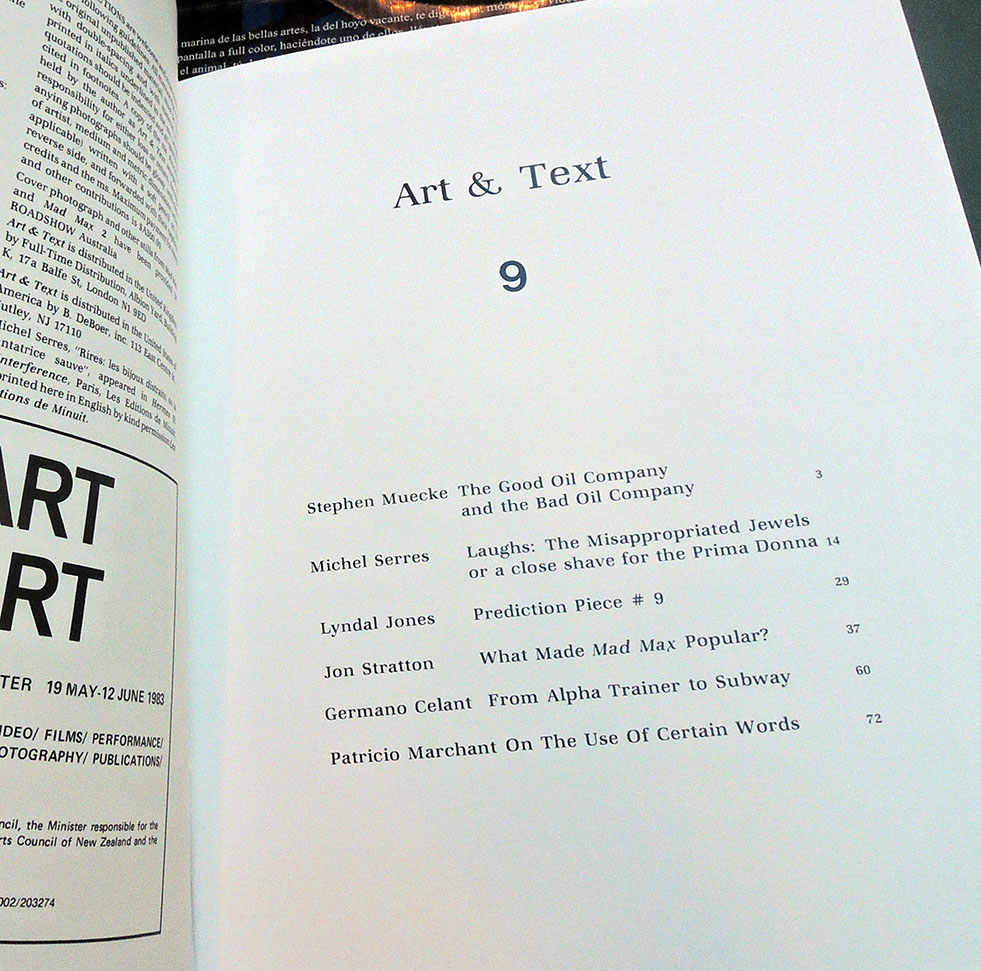 Biblia/Pietá contains the text by Carlos Leppe María Dávila on a 15 mm acrylate plate; a facsimile edition of the article in Art & Text, along with the translation by Patricio Marchant; and eleven signed photographs on rag paper.
Biblia/Pietá contains the text by Carlos Leppe María Dávila on a 15 mm acrylate plate; a facsimile edition of the article in Art & Text, along with the translation by Patricio Marchant; and eleven signed photographs on rag paper.
“The performance consisted of a staging of La Pietá with inverted gender roles, where Dávila represented the Virgin and Richard died Jesus Christ; Leppe, meanwhile, enters the scene dressed in a suit and tie, but with face makeup and false eyelashes. Leppe washes his face and lights a projection of a video where the scene of La Pietá is repeated, but this time with two men. While the video is being shown, Leppe reads aloud a text about his position on Chilean art.”
For more, see: http://carlosleppe.cl/1982-la-pieta/
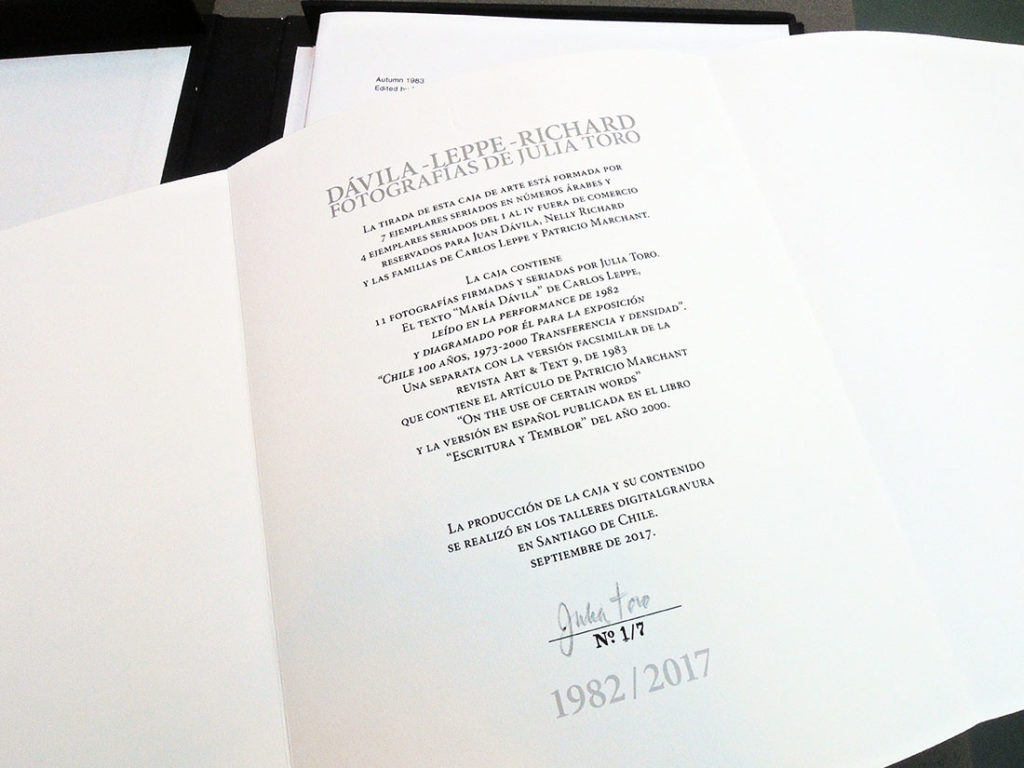
Nattini bindings
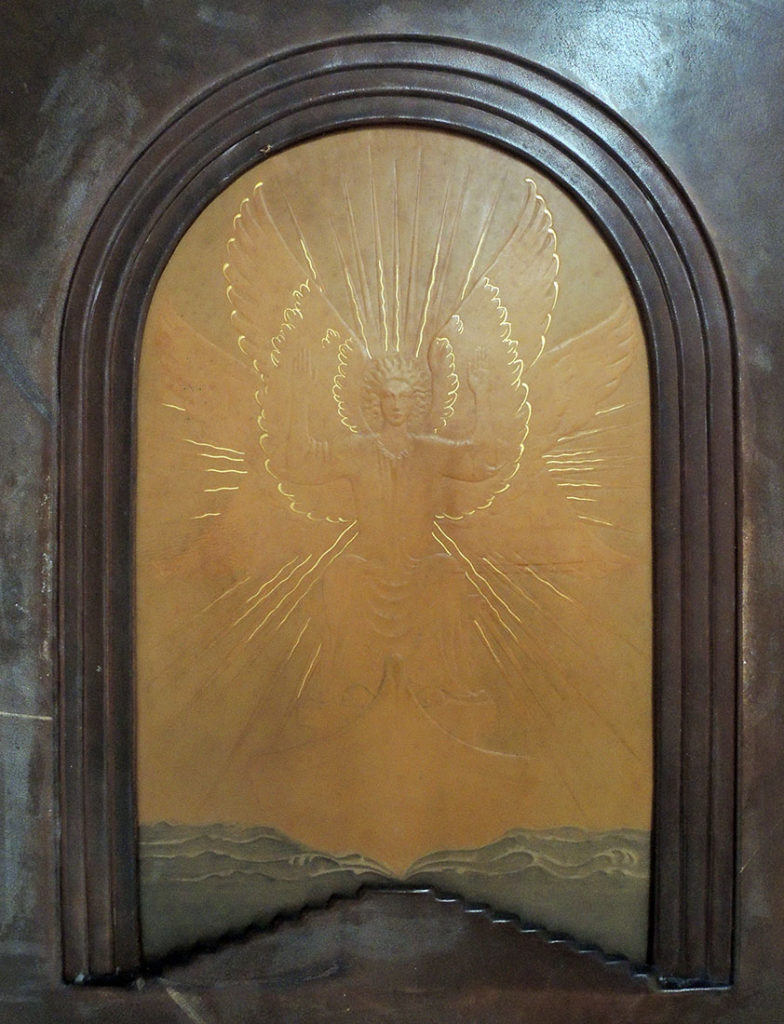 Volume 3 front cover
Volume 3 front cover
The question yesterday was, What is on the back of the Nattini binding?
As first posted in 2011, the Graphic Arts Collection is fortunate to hold one complete bound set of Dante’s Divine Comedy imagined by the artist Amos Nattini (1892-1985), along with one partially unbound set. At 82 cm long and perhaps 20 pound each, these do not move from the shelf often. 
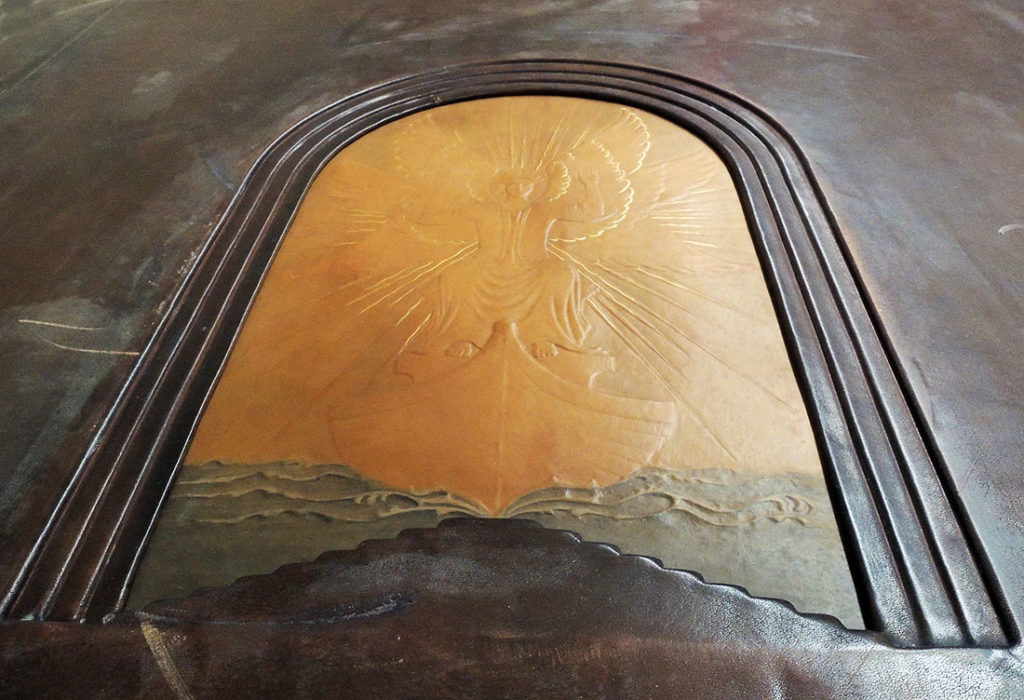 Dante Alighieri (1265-1321), La Divina Commedia, Imagini di Amos Nattini (Milano: Istituto nazionale dantesco, [1923-1941]). GAX Oversize PQ4302 .F23e. Three volumes; 82 cm. each. 100 color lithographs by Amos Nattini (1892-1985). https://www.princeton.edu/~graphicarts/2011/07/amos_nattini.html
Dante Alighieri (1265-1321), La Divina Commedia, Imagini di Amos Nattini (Milano: Istituto nazionale dantesco, [1923-1941]). GAX Oversize PQ4302 .F23e. Three volumes; 82 cm. each. 100 color lithographs by Amos Nattini (1892-1985). https://www.princeton.edu/~graphicarts/2011/07/amos_nattini.html
In 1921, on the occasion of the 600th anniversary of Dante Alighieri’s death, the Istituto nazionale dantesco in Milan commissioned a new, illustrated edition of the poet’s Divine Comedy. The artist chosen for the project was Amos Nattini, who was charged with creating one plate for each canto. For the next twenty years, Nattini worked on his Dante, releasing each of the three volumes are they were completed in 1928, 1936, and finally 1941.
Perhaps because of the length of time between volumes, the first and second are bound with similar designs while the third volume has its own design. Here are the front and back, along with this lovely design for the screws. The books are now heading to conservation for a good cleaning.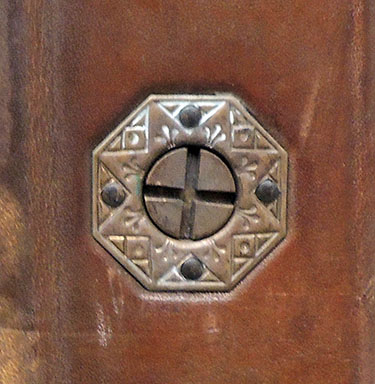
 Detail of volume 3 back cover.
Detail of volume 3 back cover.
We are extra fortunate in Princeton, since both the Princeton Theological Seminary and the Institute for Advanced Study Library are listed as also having sets of Nattini’s Dante. This has not been confirmed in person.
 Detail of volume 1 back cover.
Detail of volume 1 back cover.
Special thanks go to Mike Siravo who helped to lift volumes.
Curtis in Alaska
 While Edward Curtis (1868-1952) is best remembered for his 2,200 photogravures (ink prints from photographic negatives) published in the 20 volume set, The North America Indian, he began publishing his photographs with images from the Alaskan/Yukon Gold Rush of 1897, and more importantly, as one of the official photographers on E.H. Harriman’s Alaskan expedition of 1899. It was through the Harriman project that Curtis was introduced to the master printers at John Andrew and Son in Boston, who transformed his glass positives into rich aquatinted photogravures. Curtis went on to enlist their services again with his own mammoth series.
While Edward Curtis (1868-1952) is best remembered for his 2,200 photogravures (ink prints from photographic negatives) published in the 20 volume set, The North America Indian, he began publishing his photographs with images from the Alaskan/Yukon Gold Rush of 1897, and more importantly, as one of the official photographers on E.H. Harriman’s Alaskan expedition of 1899. It was through the Harriman project that Curtis was introduced to the master printers at John Andrew and Son in Boston, who transformed his glass positives into rich aquatinted photogravures. Curtis went on to enlist their services again with his own mammoth series.
When Curtis knew them, the engraving firm was in its thirtieth year, run by John’s son George Theodore Andrew (1843-1934) and their technical skill made it worth the cross-country shipping. Although the scale of the Alaska prints does not compare with the prints in The North American Indian, many of the photogravures in Alaska are equally rich in detail and texture.
The Harriman Expedition to Alaska was the last great 19th-century survey of the North American frontier…
Curtis’ relationship with Harriman, Robert Grinnel, a leading ethnographic expert on Native Americans and other members of the party had a great influence on the rest of his life. After a trip of nine thousand miles the party returned with five thousand pictures and over six hundred animal and plant species new to science. New glaciers were mapped and photographed and a new fjord was discovered. Curtis photographed many of the glaciers, but it was his Indian pictures on this trip that established his artistic genius. Curtis produced a souvenir album of photographs for the participants.
http://www.klotzgallery.com/edward-s-curtis-bio
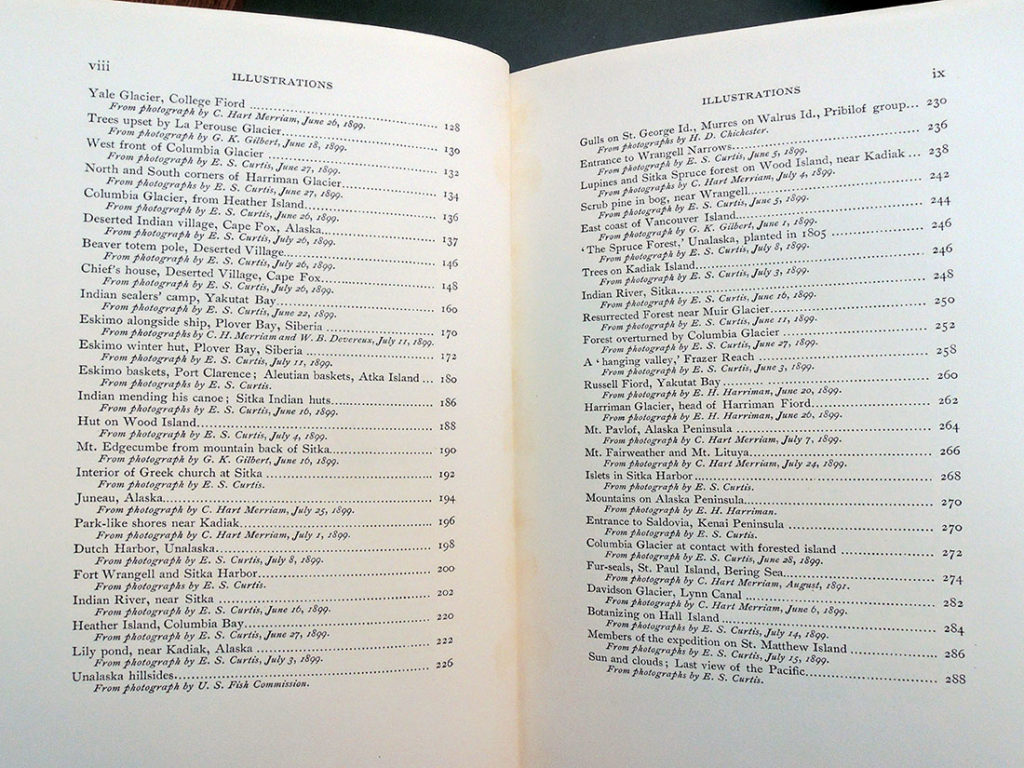
Harriman Alaska Expedition (1899), Alaska… (New York: Doubleday, Page & Company, 1901). “Advertisement. The publication of the series of volumes on the Harriman Alaska Expedition of 1899, heretofore privately printed, has been transferred to the Smithsonian institution by Mrs. Edward H. Harriman, and the work will hereafter be known as the Harriman Alaska series of the Smithsonian institution. The remainder of the edition of volumes I to V, and VIII to XIII, as also volumes VI and VII in preparation, together with any additional volumes that may hereafter appear, will bear special Smithsonian title pages. Smithsonian institution … July, 1910.” ReCAP WA Q115 .H2 1901
Alice Guy Blaché, First Female Filmmaker
 Detail from Hook and Hand [poster] from [Alice Guy] Blaché productions. Chromolithograph. 1913. Film opened February 1914, produced by her husband Herbert Blaché.
Detail from Hook and Hand [poster] from [Alice Guy] Blaché productions. Chromolithograph. 1913. Film opened February 1914, produced by her husband Herbert Blaché.
From 1896 to 1906 Alice Guy was probably the only woman film director in the world. She had begun as a secretary for Léon Gaumont and made her first film in 1896. After that first film she directed and produced or supervised almost six hundred silent films ranging in length from one minute to thirty minutes, the majority of which were of the single-reel length. In addition, she also directed and produced or supervised one hundred and fifty synchronized sound films for the Gaumont Chronophone.
—https://wfpp.cdrs.columbia.edu/pioneer/ccp-alice-guy-blache/

See also:
https://www.nytimes.com/2019/04/25/movies/be-natural-untold-story-alice-guy-blache-review.html
Emmanuelle Gaume, Alice Guy, la première femme cinéaste de l’histoire : roman (Paris: Editions Plon, [2015]). Firestone Library PQ2707.A945 A625 2015
Daniel Chocron, Alice Guy: pionnière du cinéma ([Paris]: Jardin d’essai, c2013). Firestone Library PN1998.3.G89 C46 2013
Alison McMahan, Alice Guy Blaché: lost visionary of the cinema (New York; London: Continuum, 2002). ReCAP PN1998.3.G89 M39 2002

